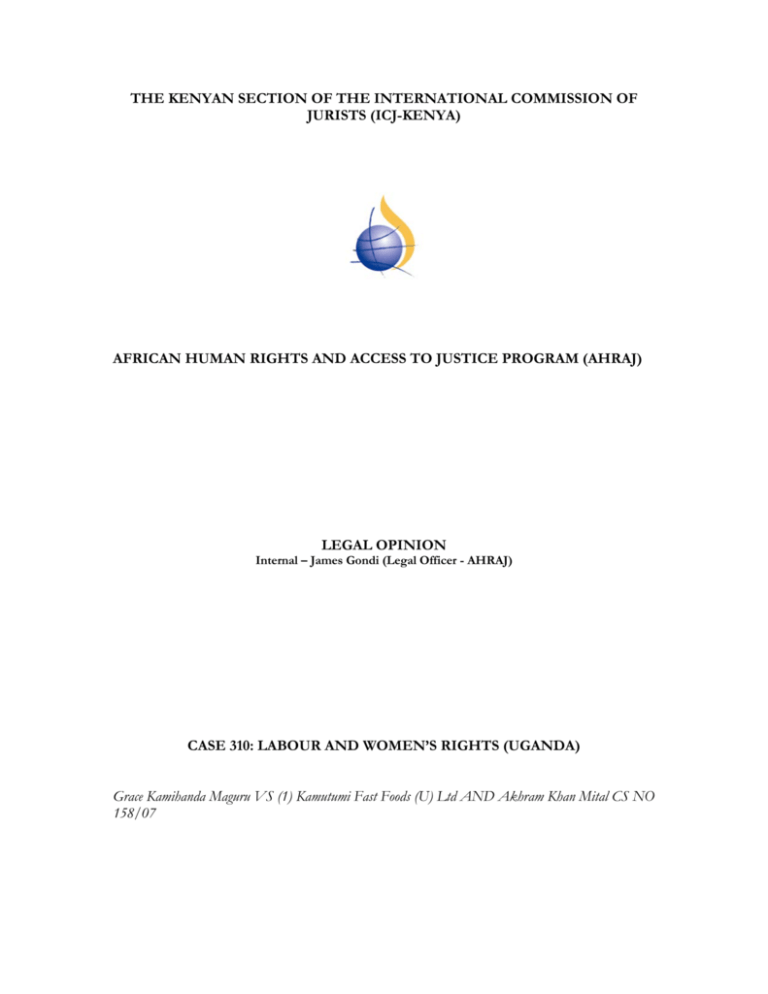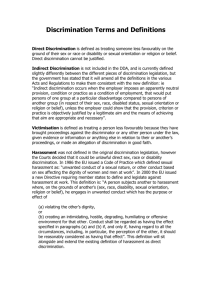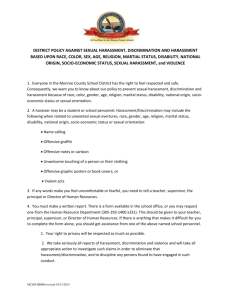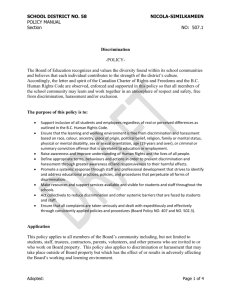
THE KENYAN SECTION OF THE INTERNATIONAL COMMISSION OF
JURISTS (ICJ-KENYA)
AFRICAN HUMAN RIGHTS AND ACCESS TO JUSTICE PROGRAM (AHRAJ)
LEGAL OPINION
Internal – James Gondi (Legal Officer - AHRAJ)
CASE 310: LABOUR AND WOMEN’S RIGHTS (UGANDA)
Grace Kamihanda Maguru VS (1) Kamutumi Fast Foods (U) Ltd AND Akhram Khan Mital CS NO
158/07
Introduction
The Plaintiff was an employee of Kamutmi Fast Foods (U) Ltd between 1999 and 2005
when she was summarily dismissed after registering complaints of sexual harassment and
assault against her managers to her employer and the police. The Second defendant was the
plaintiff’s immediate boss and in January 2005 initiated sexual advances towards the Plaintiff
contrary to company policy and in disregard of the plaintiff’s objection. In February of the
same year, the plaintiff wrote a comprehensive report of her experiences and submitted it to
the human resource and gender officer.
The second defendant disregarded this and proceeded to further assault the plaintiff by
attempting to undress her in the course of her duties in the store. The second defendant
groped the plaintiff’s breast and forcefully kissed her on several occasions. She filed several
reports with management until finally resorting to filing a report of indecent assault with the
Uganda Police (Kyaka II Police post – vide prf-kii/crb 9126/11/05). The complaints and
reports were fully documented and are available to the trial attorneys.
Criminal proceedings were brought against the second defendant who, under the protection
of the 1st defendant was transferred to Nairobi and later flown to Mumbai, India resulting in
the collapse of those proceedings. The present claim is therefore against the company
(Kamutumi Fast Foods Ltd) which had employed the plaintiff.
The present opinion is of the view that the actions of both the defendants herein constitute
discrimination on the ground of sex in contravention of the national laws of Uganda, its
constitution and relevant international treaties to which Uganda is a state party. Further, the
circumstances surrounding the dismissal of the defendant and the manner in which the
dismissal was carried out is in contravention of Uganda’s employment laws, the constitution
of Uganda and International Labour Organization (ILO) standards governing the rights of
women, and all workers generally.
It is the view of this opinion that the treatment of the defendant constituted employment
discrimination on the basis of gender in contravention of the Constitution of Uganda, the
Employment Act of Uganda, the Convention on the Elimination of All Forms of
Discrimination against Women, the ILO Convention concerning Discrimination in Respect
of Employment and Occupation as well as other international instruments, standards,
practices and jurisprudence.
The Constitution of the Republic of Uganda
Section 33 (1) of the Constitution of Uganda protects the dignity of women by stipulating
that:
“Women shall be accorded full and equal dignity of the person with men”1
1
Constitution of the Republic of Uganda (1995) Section 33(1).Available at http://confinder.richmond.edu
2
Further, Section 21 of the same constitution which guarantees ‘equality and freedom from
discrimination’ stipulates under sub-section two (2) that:
“A person shall not be discriminated against on the ground of sex, race, colour,
ethnic origin, tribe, birth, creed, or religion, social or economic standing, political
opinion or disability”. 2
Constitution of the Republic of Uganda, its supreme law, therefore prohibits discrimination
on the grounds of sex and bestows upon women commensurate standing to men in all
spheres of life, the workplace included.
The treatment of the Plaintiff (Grace Kamihanda Maguru) at the hands of her employers
was clearly in violation of her constitutional rights to non-discrimination on the basis of sex
and the right to be accorded equal dignity of the person with men. The respondent’s
behavior (failing to protect the plaintiff from sexual harassment) was peculiar to the plaintiff,
who was the only woman serving in direct contact with the defendant at management level.
It is arguable; therefore, that she was treated as such due to her sex since the same treatment
was not meted out on the defendant’s male colleagues. In so doing, the defendants violated
the plaintiffs constitutionally guaranteed rights.
Statutes
The Employment Act of Uganda (Act no 6 of 2006) establishes the offence of sexual
harassment in consonance with international standards governing workers rights. This is a
newly adopted act which replaces the Employment Act of 2000. The 2006 Act forges new
rights and preserves some of the existing ones:
“The new rights include: protection from forced labour, protection from
discrimination in employment due to “race, colour, sex, religion, political opinion,
natural extraction or social origin, the HIV Status or disability which has the effect of
nullifying or impairing the treatment of a person in employment or occupation, or
preventing an employee from obtaining any benefit under a contract of service”
[Section 6 (3)] and protection from sexual harassment by the employer (Section
7). Others are the right to written particulars of the contract (Section 59), the right
to a fair hearing before dismissal (Section 69), the right to reinstatement
and/or compensation in cases of unfair dismissal (Section 71) and remedies of
compensation and additional compensation in cases of unfair termination (Section
77 & 78), and severance pay (Sections, 87 to 89)”.3
The behavior of both defendants in the present case contravened Section 7 of the
Employment Act of Uganda 2006. On the part of the second defendant, the said defendant
is culpable under the Penal Code for indecent assault.
Constitution of the Republic of Uganda (1995) Section 21(2).Available at http://confinder.richmond.edu
Freedom of Association and Uganda’s New Labour Laws: A Critical Analysis of the State of Workers’
Organizational Rights (John Jean Barya) Human Rights and Peace Centre (HURIPEC), 2007.
2
3
3
More importantly, however, because the present claim is against the company, the
management of the company are in breach of the Section 7 of the Employment Act (2007)
on account of failing to protect the plaintiff from sexual harassment by the second
defendant (a senior manager with the corporation) as per its statutory duty despite several
complaints made by the plaintiff to the relevant structures of the company responsible for
the protection of its employees in respect of sexual harassment and enforcing company
policy and requisite disciplinary mechanisms to end the abuse that the plaintiff was being
subjected to.
International Treaties and Instruments
International human rights standards governing the rights of women have established the
consideration of sexual harassment against women as amounting to discrimination against
women which is proscribed at international law.
Gender Discrimination
The Convention on the Elimination of All Forms of Discrimination against Women
(CEDAW) which Uganda ratified in 1985 prohibits all forms of discrimination against
women and calls upon state parties to take relevant measures to ensure the same.
Article 5 (a) of the Convention calls upon State parties to:
“to modify the social and cultural patterns of conduct of men and women, with a
view to achieving the elimination of prejudices and customary and all other
practices which are based on the idea of inferiority or the superiority of either
of the sexes or on stereotyped roles for men and women”.4
Article 11 of the same Convention calls on State Parties to take all appropriate measures to
“Eliminate discrimination against women in the field of employment in order to
ensure, on a basis of equality of men and women, the same rights.”5
In particular, Article 11 (c) protects:
“The right to free choice of profession and employment, the right to promotion,
job security and all benefits and conditions of service and the right to receive
vocational training and re-training, including apprenticeships, advanced vocational
training and recurrent training”6
4 The Convention on the Elimination of All forms of Discrimination against Women (CEDAW) Article 5 (a).
Available at http://www.ohchr.org/english/law/cedaw.htm
5
Ibid Article 11 (c)
4
Reading Article 5 and 11 together and applying the same to the circumstances of the present
case reveals specific violations of the Plaintiff’s rights under the said convention. Specifically,
sexual harassment and unequal treatment based on gender typically involves the exercise of
power and authority over women, resulting in the reinforcement of a woman’s subordinate
status in relation to men.
This is the precise problem that Article 5 aims to address and prohibit by referring to
practices which are based on the idea of inferiority or the superiority of either of the
sexes. By logical abstraction, this applies to the work place which is referred to at article 11
which prohibits all forms of discrimination against women in respect of conditions of
service which discrimination is oft triggered by sexual harassment. The rights of the Plaintiff
in the above respect have been violated by her employer. The state, judicial arms included,
are under an international obligation to preserve and protect the same.
Discrimination against women is also addressed in other international treaties, to varying
degrees, including the Universal Declaration on Human Rights (UDHR), the International
Covenant on Civil and Political Rights (ICCPR), the International Covenant on Economic,
Social and Cultural Rights (ICESCR).
“Other international human rights instruments do not specifically define
‘discrimination against women’. Rather, they mandate equality of treatment between
men and women. Under Article 2 of the ICCPR, each state party undertakes to
respect and ensure to all individuals within its territory and subject to its jurisdiction,
the rights recognised in the present Covenant, without distinction of any kind such
as race, colour, sex, language, religion, political or other opinion, national or social
origin, property, birth or other status.”7
Further, Article 3 of the ICESCR requires state parties to ensure the equal right of men and
women to the enjoyment of all economic, social and cultural rights set forth in the covenant.
Article 18 (3) of the African Charter on Human and Peoples Rights stipulates that the State
shall:
“The State shall ensure the elimination of every form of discrimination against
women and also ensure the protection of the rights of the woman and the child as
stipulated in international declarations and conventions”.8
Thus, the African Charter reinforces the duties of state parties to ensure the application of
anti-discriminatory policies and practices against women as enshrined in conventions such as
CEDAW, UDHR, ICCCPR and ICESCR.
Gender Discrimination in Respect of Employment
The ILO Convention concerning Discrimination in Respect of Employment and
Occupation, 1958 – ILO convention number C111 (ratified by Uganda in 2005) proscribes
Human Rights Litigation and the Domestication of International Human Rights Standards in sub Saharan
Africa. AHRAJ Case Book One (1) Chapter Two by Wachira Maina LL.M at Page 43.
8 Ibid
7
5
discrimination on the basis of sex in relation to employment conditions and practices. Article
11 (1) (a) states that for the purpose of this Convention, the term ‘discrimination’ includes
“Any distinction, exclusion or preference made on the basis of race, colour, sex,
religion, political opinion, national extraction, or social origin, which has the effect of
nullifying or impairing equality of opportunity or treatment in employment or
occupation”.9
The ILO Resolution on Gender Equality, Pay Equity and Maternity Protection of June 2004
re-stated the same proscriptions on discrimination in its action plan for gender
mainstreaming. Further, the ILO Committee of Experts has alluded to a prohibition of
sexual harassment by virtue of Convention 111.10
Uganda has ratified ILO Convention C111 and is under an obligation to adopt legislation,
policies and practices which uphold the standards set out in the convention. Through, the
Employment Act of 2006 the non-discrimination aspects have been legislated. However, this
does not circumvent the opportunity to ask the Court to apply these international standards
due to the requisite obligation to uphold them in the promotion and protection of labour
rights, particularly the right to not to be discriminated in the workplace on the basis of sex.
Case Law
Bundy vs Jackson (1981)
In this case, a hostile working environment alone was for the first time recognized (by US
Federal Appeals Court for the District of Washington D.C) as a form of harassment. In
Bundy, a female employee of the Department of Corrections in Washington D.C was
repeatedly invited by her supervisor to describe her sexual experience. When she complained
to her senior manager, he took it lightly, saying that the feelings of the supervisor were
understandable. The Court upheld Bundy’s charge that the innuendo and implicit threats
created an intimidating and hostile atmosphere, and were unlawful, even though she had not
suffered any tangible loss, such as the witholding of salary or promotion.
Vinson vs Meritor Bank (477 U.S 57 [1986])
In this case, a trainee teller was repeatedly propositioned by a vice president of the bank.
After resisting for some time, she relented for fear of losing her job and was subjected to
repeated unwanted sexual relations for four years. In this case, the court did not find it
necessary to decide whether a sexual relationship between worker and employer had
happened at all. The court held that a hostile work environment alone was a violation of
employment discrimination contrary to U.S statutes (The Civil Rights Act of 1964)
ILO Convention 111. Available at http://www.ilo.org/ilolex/cgi-lex/convde.pl?C111
Sexual Harassment in the Workplace: a Report from fieldwork in Thailand (2002). International Labour
Rights Fund. Prepared by, Ubon Kompipote. Available at
http://www.laborrights.org/projects/women/thailandreport.pdf
9
10
6
Porcelli vs Strachclyde Regional Council (1986) ICR 564, Court of Session: First Division
In this United Kingdom (UK) case, sexual harassment in the workplace was established as a
type of sexual discrimination prohibited under the Sex Discrimination Act of 1986.
Although not specifically mentioned in the Act, the Court of Session declared that sexual
harassment may be form of direct sex discrimination.11 In the same case the Court
interpreted the Sex Discrimination Act [Section 41(1)] to the effect that an act done by an
employee in the course of employment shall be treated as done by his employer as well as by
him.
Recommendations
Following the analysis above on the constitution, statute and case law available, it is clear
that there are sufficient grounds to begin and sustain an action against Kamutumi Fast
Foods (U) Ltd. The said company, being the second defendant’s employer (the second
defendant having committed direct acts of sexual assault and harassment against the
plaintiff) is equally culpable in keeping with the groundbreaking ruling in Poricelli vs. Strathclyde
Regional Council as seen hereinabove.
The most effective approach would be a civil suit for damages in tort the basis of which
would be mental anguish, physical harassment and loss of income and employment caused
by sexual harassment. It would also need to be emphasized that the said loss of income and
employment were brought about by the summary dismissal of the plaintiff due to the several
complaints she made to the company which instead of redressing the matter, sought to
protect the second defendant both by helping to relocate him and by dismissing the plaintiff
from her employment.
Conclusion
A hostile working environment is sufficient to constitute sexual harassment which in turn is
proscribed by the Constitution of Uganda, the Employment Act of Uganda 2006, the
Convention on the Elimination of All Forms of Discrimination against Women, the ILO
Convention concerning Discrimination in Respect of Employment and Occupation as well
as other international instruments, standards, practices and jurisprudence.
Discrimination on the basis of gender is also proscribed by the aforementioned instruments.
The Courts ought to uphold the rights of the Plaintiff which were breached by her employer
in view of the treaty obligations of the state to uphold the standards set out in the said
international instruments and the fact the sections which form the basis of the present claim
have been codified into Ugandan law via the Employment Act 2006 and the 1995
Constitution. More importantly, employment discrimination on the basis of gender, in the
11 Sexual Harassment and the Law: the British Experience. Greame Lockwood, Patrice Rosenthal and
Alexandra Budjanovcanin Kings College London, University of London. Available at:
http://www.emeraldinsight.com/Insight/ViewContentServlet?Filename=/published/emeraldfulltextarticle/pd
f/0100480501.pdf
7
form of sexual harassment, is an affront on the dignity of the person in contradistinction
with the most accepted international human rights normative framework as enshrined in the
Universal Declaration of Human Rights.
8
BIBLIOGRAPHY
(1) Barya, John Jean ‘Freedom of Association and Uganda’s New labour Laws: a critical
Analysis of the State of Workers Organizational Rights’ Human Rights and Peace
Centre (HURIPEC), 2007.
(2) Convention on the Elimination of All Forms of Discrimination against Women
(CEDAW) (1979). http://www.ohchr.org/english/law/cedaw.htm
(3) Bundy vs. Jackson (1981).
(4) Constitution of Uganda (1995). http://confinder.richmond.edu.
(5) Human Rights Litigation and the Domestication of International Human Rights
Standards in Sub Saharan Africa. AHRAJ Case Book, Volume 1 (2007).
(6) ILO Convention Concerning Discrimination in Respect of Employment and
Occupation (1958) ILO Convention C111.
http://www.ilo.org/ilolex/cgi-lex/convde.pl?C111
(7) Lockwood, Rosenthal and Budjanovcanin, ‘Sexual Harassment and the Law: the
British Experience’. Kings College London, University of London. Emerald Insight
Publishers.
(8) Porcelli vs Strachclyde Regional Council (1986) ICR 564, Court of Session: First
Division.
(9) Sexual Harassment in the Workplace: a Report from fieldwork in Thailand (2002).
International Labour Rights Fund. Prepared by, Ubon Kompipote. Available at
http://www.laborrights.org/projects/women/thailandreport.pdf
(10) Sargeant M. and Lewis D. ‘Employment Law’ Ed 3 (2005) Blackwell Synergy.
(11) Vinson vs Meritor Bank 477 U.S 57 [1986].
9
10
11







